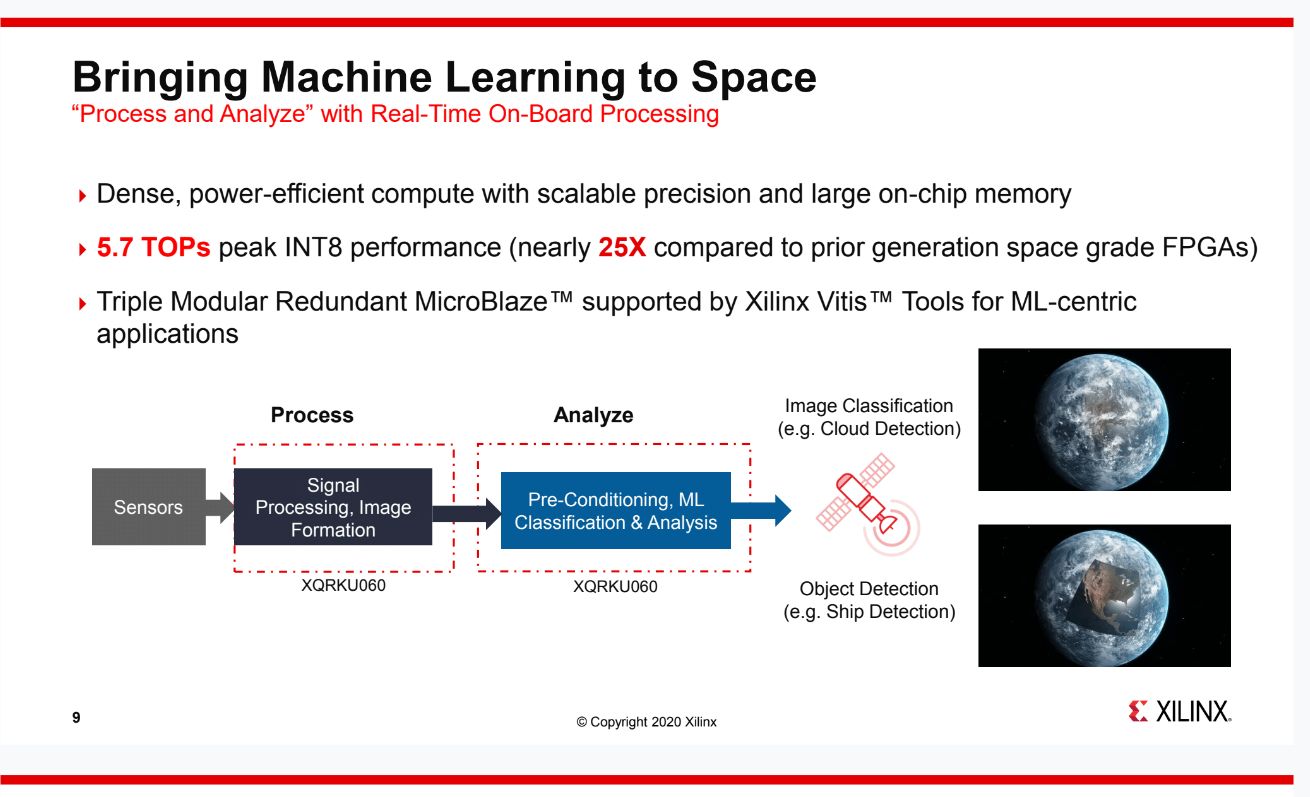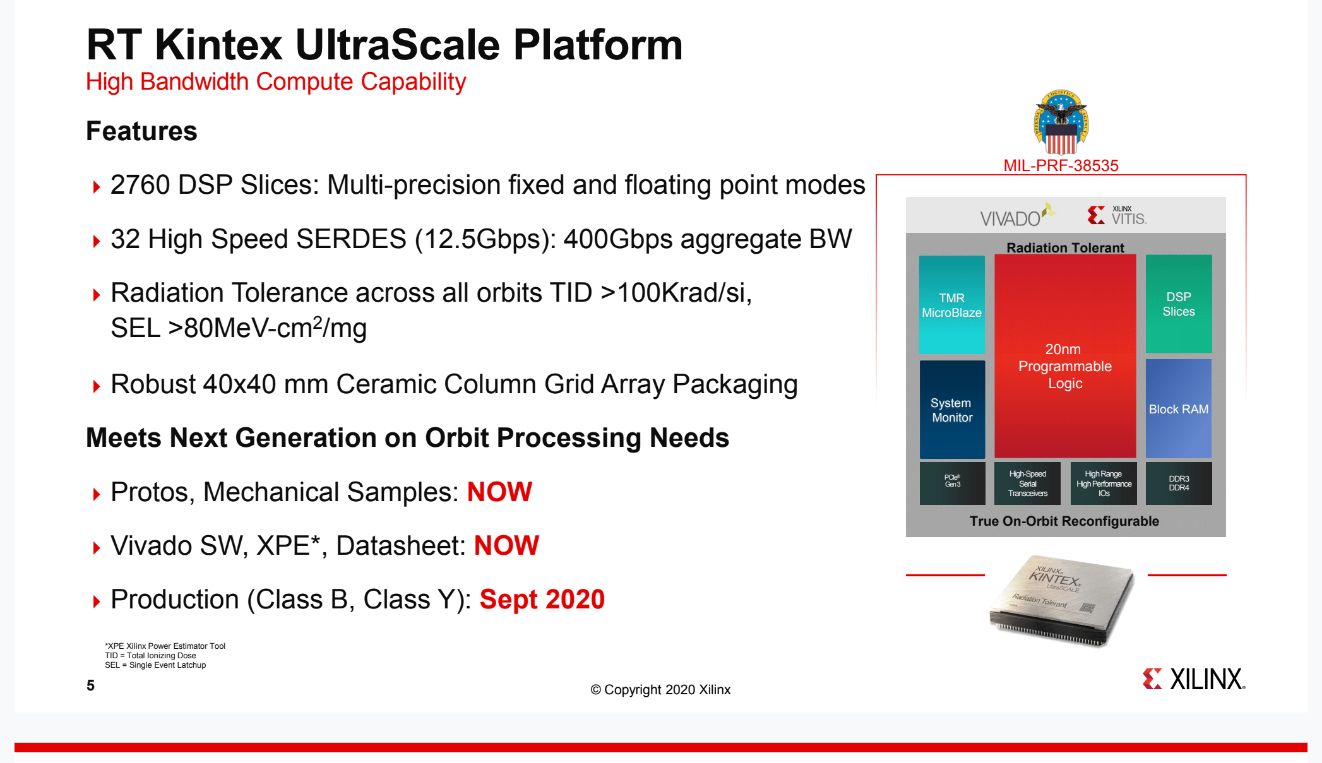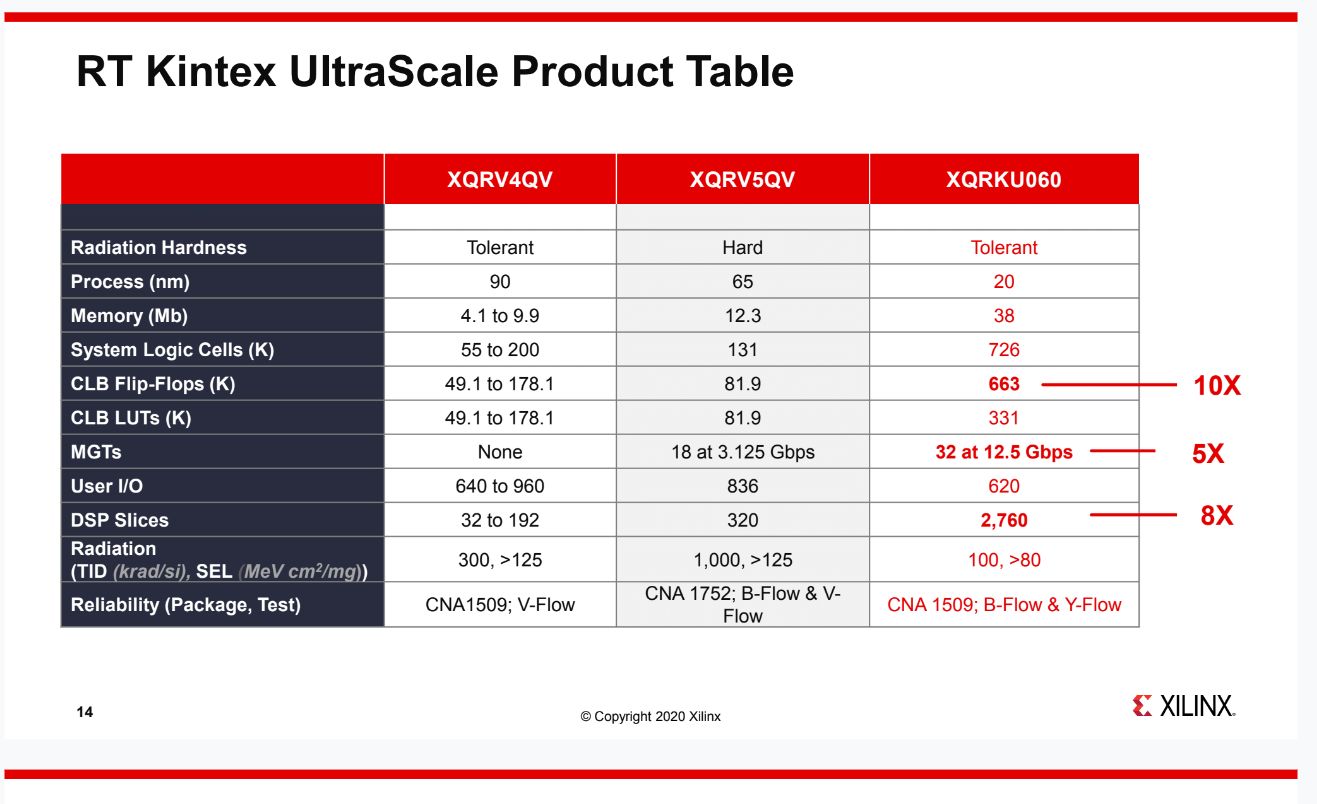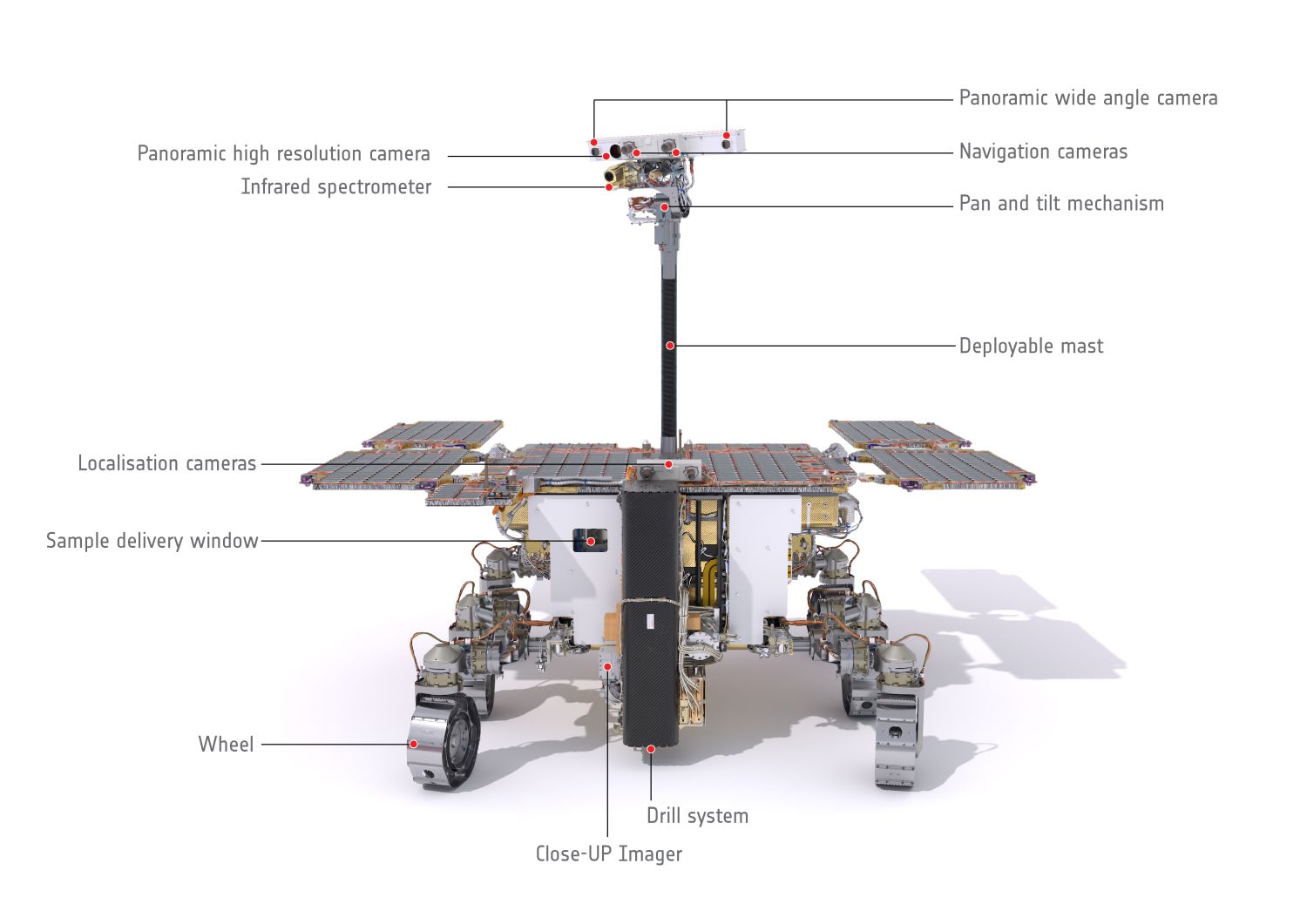Mars Rovers, most satellites, communication payloads, earth observation payloads, and space missions will be the key markets for this top of the notch product. To some trained eyes, 20nm might not seem advanced enough, but considering that the last Radiation Tolerant product was at 65nm and was launched more than half a decade ago, XQRKU060FPGA is quite impressive. We had a wonderful time chatting with Minal Sawant, Space System Architect at Xilinx, and the conversation was a speed learning curve about chips in space. She gets to work with just about anyone who wants to launch a satellite or all generations in the past and future, of Mars Rovers.
Satellites need more computation power for channelization, beamforming, or phased away processing. The Earth observation payload relies on hyperspectral cameras, and synthetic aperture radar data. Space 2.0 Constellation offers broadband internet and high-speed networks, and the last target market offers solutions for display modules, instruments, and video processing.
Let us spend a moment on satellites—Earth-observing satellites, whether civil, commercial, or defense take pictures of the earth in various resolutions. What happens in real life is close to 66 percent of the time, it is taking pictures of clouds, as two thirds of the earth are always covered by clouds. This is exciting trivia that is not well known.
As you can imagine, data links from the satellites are limited and are expensive resources. Xilinx learned that it could use machine learning and artificial intelligence to analyze images on satellite and discard blurred images or images of clouds, save the downlink and send them to the base station. Another user case could be looking for a ship in the sea, and discard all images of beautiful oceans that contain no ships.
The combination of the deep learning processing unit of Kintex UltraScale XQRKU060FPGA with the Vitis AI software stack, using CNNs and MLPs (multilayer perceptron ) networks, gets the job done. No other ASIC or competing programable solution can do this, it's claimed.
RT Kintex powered Grace, MER, and TerraSAR. MER is better known as the Mars Exploration Rover, launched in 2003 and landed in 2012. The longevity of the product plays a crucial role, and this is why Xilinx landed all space rovers in the past and the future. Its Kintex solution powers Curiosity rover, OSIRIS Rex and Iridium NEXT satellites and will be a part of Perseverance MARS2020, EcoMARS - a new Rover set to launch in 2022 - and NextGen Satellite Payloads
Challenges
Communications in space are downlink bandwidth limited and require low latency and high bandwidth. The new Kintex also offers machine learning in orbit and can be reprogrammed and repurposed. In space exploration, the re-use of a platform can save millions of dollars as a single satellite launch can cost 100s of millions of dollars. Machine learning in space in orbit can make sense of data and save bandwidth than rather than clogging the downlink. The space industry is looking for a flexible system architecture that can be changed on the fly with reliable components, radiation tolerant and size, weight, and power-efficient.
A tough task to address, but 20nm RT Kintex UltraScale FPGA seems to be doing the job. It is a true unlimited on-orbit reconfigurable solution. Yes, this means that it can be programmed in space. It offers more than 10X DSP compute increase for processing-intensive algorithms and analytics, and it is full radiation-tolerant across all orbits. The machine learning ecosystem enables high-performance edge inference in Space.
RT Kintex UltraScale Platform
The platform features high bandwidth compute capability, including 2760 DSP slices with multi-precision fixed and floating-point modes, 32 high-speed SERDES 12.5 Gbps, and 400 Gbps aggregated bandwidth. The radiation tolerance across all orbits TID>Krad/si, SEL>80MeV-cm2/mg. One of the unique features is a robust 40x44 mm Ceramic column Grid away packaging that is helping to shield the chip from the space radiation. The chip has to withstand Space radiation, extreme temperature changes, rocket launch, and extreme G-forces that can bend some traditional packages, but ceramics can withstand that. It is all designed towards Reliability for Space. You cannot merely stop a mission that takes 10 to 15 years and return a space ship to do additional repairs and update the chip.
Prototypes and mechanical samples are available now, Vivado software and the Xilinx Power Estimator tool including the datasheet are available now. At the same time, the production of both Class B and Class Y is expected in September 2020.
Unlimited On-Orbit Reconfiguration
RT Kintex UltraScale Platform offers true unlimited On-Orbit Reconfiguration, it is claimed and an engineer can fix a bug or reprogram/repurpose the FPGA in the future. ASIC chips don’t have this flexibility, as they are “baked“ and you cannot reprogram or repurpose the hardened algorithms.
One beauty of a programmable solution that can be repurposed is that machine learning algorithms and needs can be updated. A satellite programmed to look for ships can be repurposed in the future, and new algorithms and more efficient neural networks can be changed and applied in the future.
Machine learning in space
The RT Kintex UltraScale Platform can process and analyze data with real-time onboard processing, it is claimed. The peak INTE8 performance of 5.7 TOPs is nearly 25 times more compared to a prior generation space-grade FPGA. A massive performance increase between two generations indicates the importance of machine learning in space exploration.
Developers can use existing frameworks including Keras, TensorFlow or PyTorch, FINN, hls4ml, or Vitis AI compiles, and neural networks inference acceleration is dynamically loadable. Once Vitis AI gets enabled, DPUs will be able to use NN inference acceleration, too, but this is planned for the future update.
The solution offers low-latency, high-throughput performance with customizable pre/post-processing for CNNs & MLPs with multi-precision network support optimized for INT8 and below.
Xilinx 20 nm Space-Grade Radiation Tolerant (RT) Kintex UltraScale XQRKU060FPGA is a brain of the compute ecosystem solution. Still, the ecosystem includes multiple partners, including Infineon tech for SRAM, Infineon, Cobham for NVM, 3DPlus providing DDR3, Cobram for MCU, TMR synthesis tool by Mentor graphics, IP by Star Dundee, Power Solution by Texas instrument and High-Speed ADC by Texas instrument, Teledyne e2V.
Reconfigurable Telecommunication Satellite
One great example is that a telecommunication satellite can be updated in the future. Operators can change and adapt frequency plans, channelization bandwidths, and routing uplinks to specific downlink.
Reconfiguration of the satellite can be done by storage of multiple bitstreams in the Non Volatile memory, onboard computer, or even the ground station.
One of the clients uses the 20nm UltraScale reconfigurable platform for a GEO SatCom production. The SEAKR Engineering, Inc. Colorado is building reconfigurable processors based on 20nm UltraScale KU060. The base function of the satellite is to interconnect with 12 Gbps SERDES links, enabling high throughput, flexible and reconfigurable modulation, demodulation, channelization, and routing capability.
The Kintex XQRKY060 20nm based product supports 12GHz X, 18GHz Ku Bands, and 40GHz Ga band with 50GHz Q and 60GHz U bands support planned for the future. There will be a next-generation solution featuring SIP, higher density FPGA, next-gen nodes, XQ ruggedized, machine learning-focused, and supporting Vitis. Still, the company didn’t want to go into any further details.
It is claimed the Xilinx 20 nm Space-Grade Radiation Tolerant (RT) Kintex UltraScale XQRKU060FPGA will make future satellites smarter. Satellites will be able to be reprogrammed and repurposed. They will do edge computing on the vessel itself, without the need to send 66 percent of cloud pictures when a satellite is tracking ships or helping map companies to map the world.
The next-generation European Space agency EXOMars (Rover) will also use Xilinx technology launching in 2022, and will help it make sense of the data that it collects on Mars, and it will even help to send it back. Simply amazing. 




